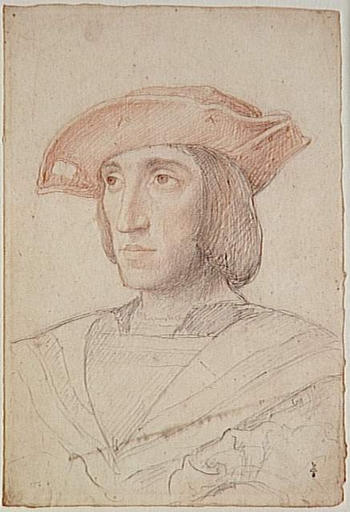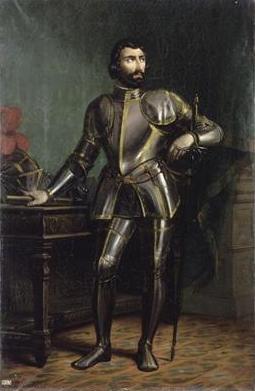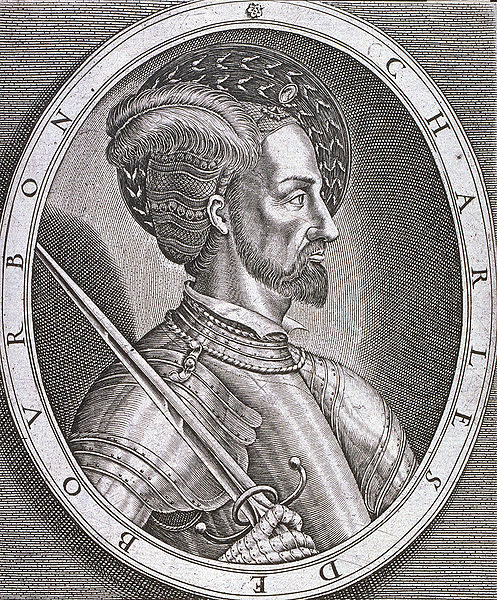<Back to Index>
- Humanist Rodolphus Agricola, 1444
- Writer Gustavo Adolfo Domínguez Bastida (Bécquer), 1836
- Duke of Bourbon and Auvergne Charles III, 1490
PAGE SPONSOR



Charles III, Duke of Bourbon (February 17, 1490 – May 6, 1527) was a French military leader, the Count of Montpensier and Dauphin of Auvergne. He commanded the Imperial troops of Holy Roman Emperor Charles V in what became known as the Sack of Rome in 1527, where he was killed.
Charles was born at Montpensier. His father, Gilbert, Count of Montpensier, died in 1496, and his elder brother Louis II, Count of Montpensier, in 1501, at which time he inherited the family lands in Auvergne. His mother was Clara Gonzaga (1 July 1464 - 2 June 1503), a daughter of Federico I Gonzaga, Marquess of Mantua, and Margaret of Bavaria.
On 10 May 1505 Charles married Suzanne, Duchess of Bourbon, the heir - general of the House of Bourbon (of which he was the heir - male), and became Duke of Bourbon in her right.
Already distinguished as a soldier in the Italian Wars, he was appointed Constable of France by Francis I of France in 1515, and was rewarded for his services at the Battle of Marignano (where he commanded the vanguard) with the Governorship of Milan. However, Francis was uneasy with the proud and wealthy duke, and soon recalled him from Milan and refused to honor his debts. Charles was further angered by the appointment of Charles IV of Alençon, the King's brother-in-law, as commander of the vanguard during the campaigns in the Netherlands, an office which should have been his.
The death of his wife in 1521 provoked the final breach. Suzanne had left all her estates to him, but the King's mother, Louise of Savoy, claimed them as the heir in proximity in blood, due to their previous entailments. She proposed to settle the question by marrying Charles; but he refused the proposal. On behalf of his mother, Francis confiscated a portion of the Bourbon estates before the lawsuit had even been settled. Seeing no hope of prevailing, Charles made a secret agreement to betray his King and offer his services to the Holy Roman Emperor Charles V. The Emperor, the Constable, and King Henry VIII of England devised a grand plan to partition France, which came to nothing; the plot was discovered and Charles was stripped of his offices and fled into Italy in 1523. In 1524, he drove the French under Bonnivet from Lombardy, and fought at the Battle of Pavia.
The Emperor gave Duke Charles command of a mixed Spanish - German army (which included a number of Lutherans) sent to chastise Pope Clement VII. He neglected to supply this army with money or food, and Charles was only able to keep it together by promises of loot. Though Clement arranged a truce with the Emperor, the army continued its advance, reaching Rome in May, 1527. The death of Duke Charles — the artist and goldsmith Benvenuto Cellini claimed that he fired the shot that killed him — outside the walls removed the last restraints from the army, which resulted in the sack of Rome.
By Suzanne, Charles was the father of a pair of twins and Francis of Bourbon, Count of Clermont. Since none of them survived a year of age, the senior line of the Dukes of Bourbon was extinct in male line with his death in battle, and the junior line (Dukes of Vendôme) were not allowed to inherit, because Charles had forfeited his fiefs by committing treason. However, the county of Montpensier and dauphinate of Auvergne were later returned to his sister Louise.
In conspiracy theories, such as the one promoted in The Holy Blood and the Holy Grail, he has been alleged to be the thirteenth Grand Master of the Priory of Sion, although he is only listed by his title.